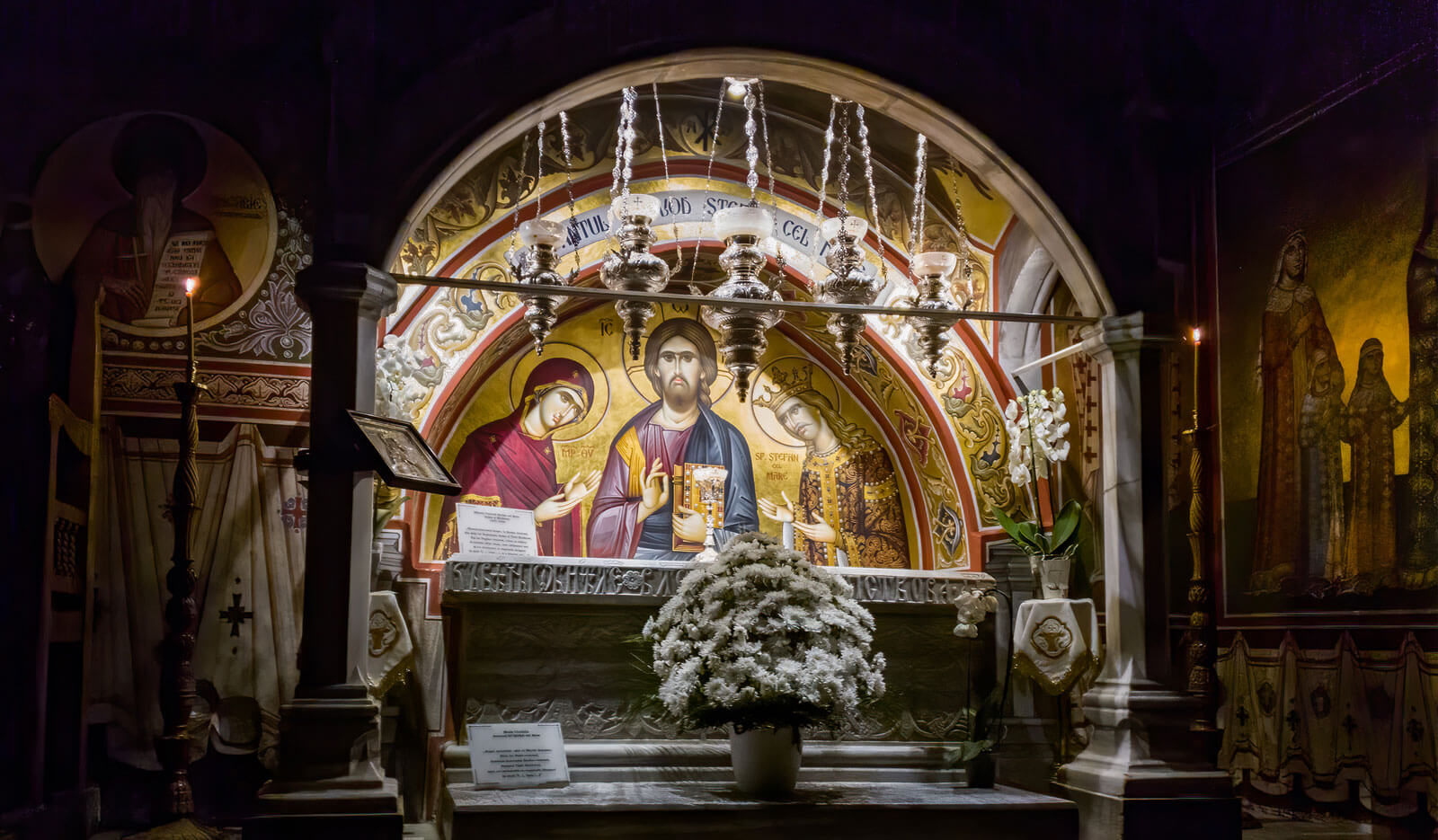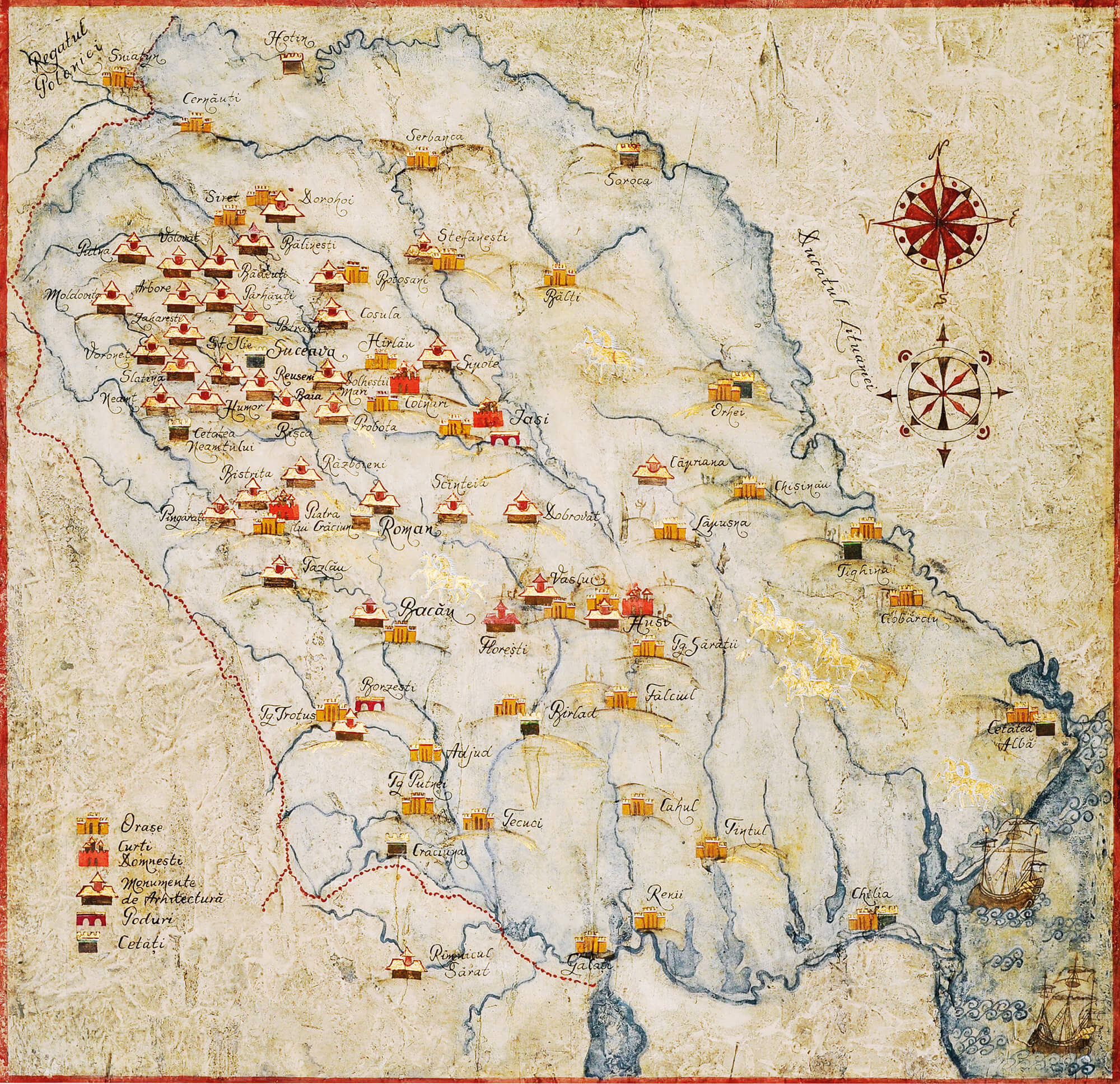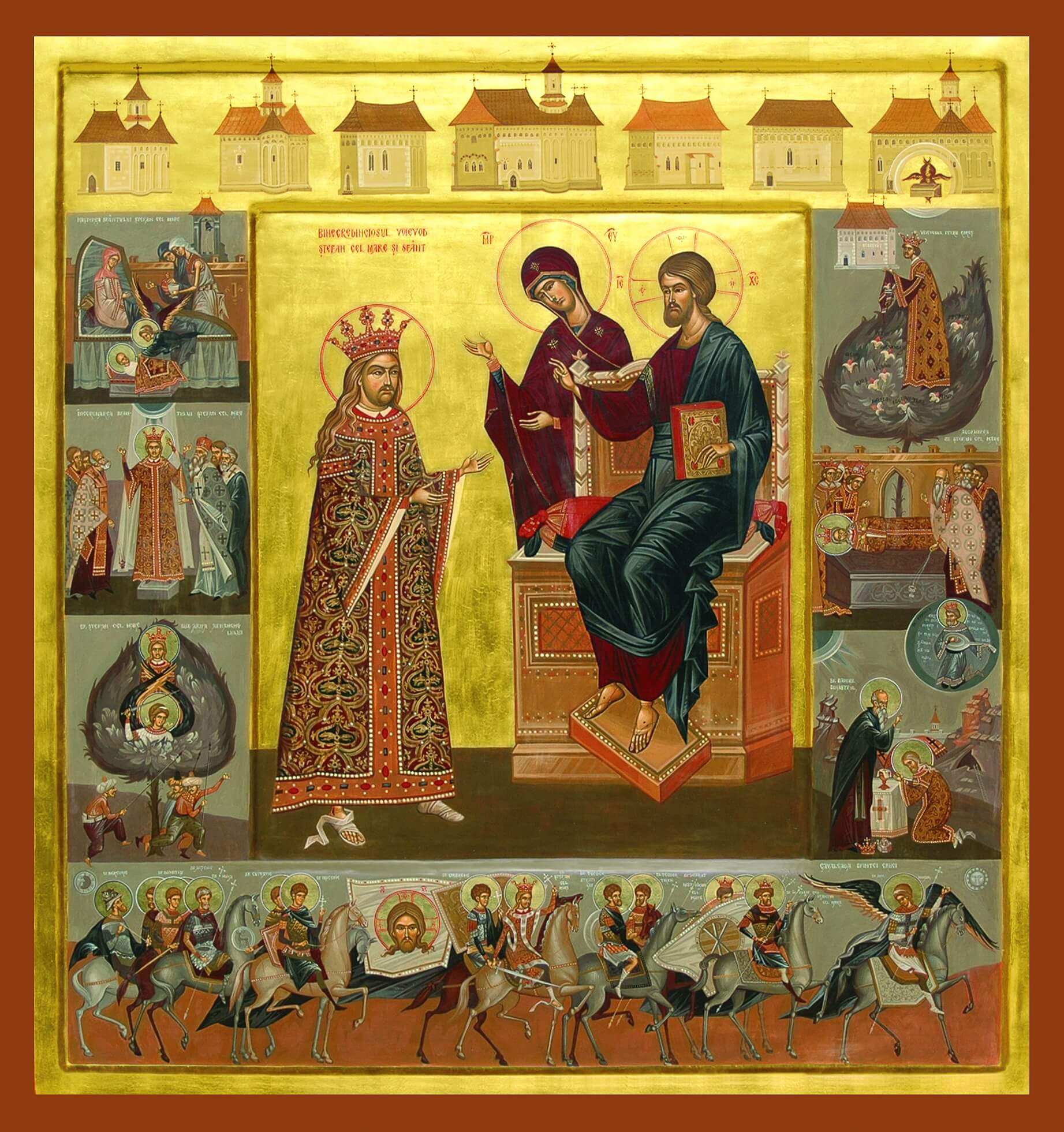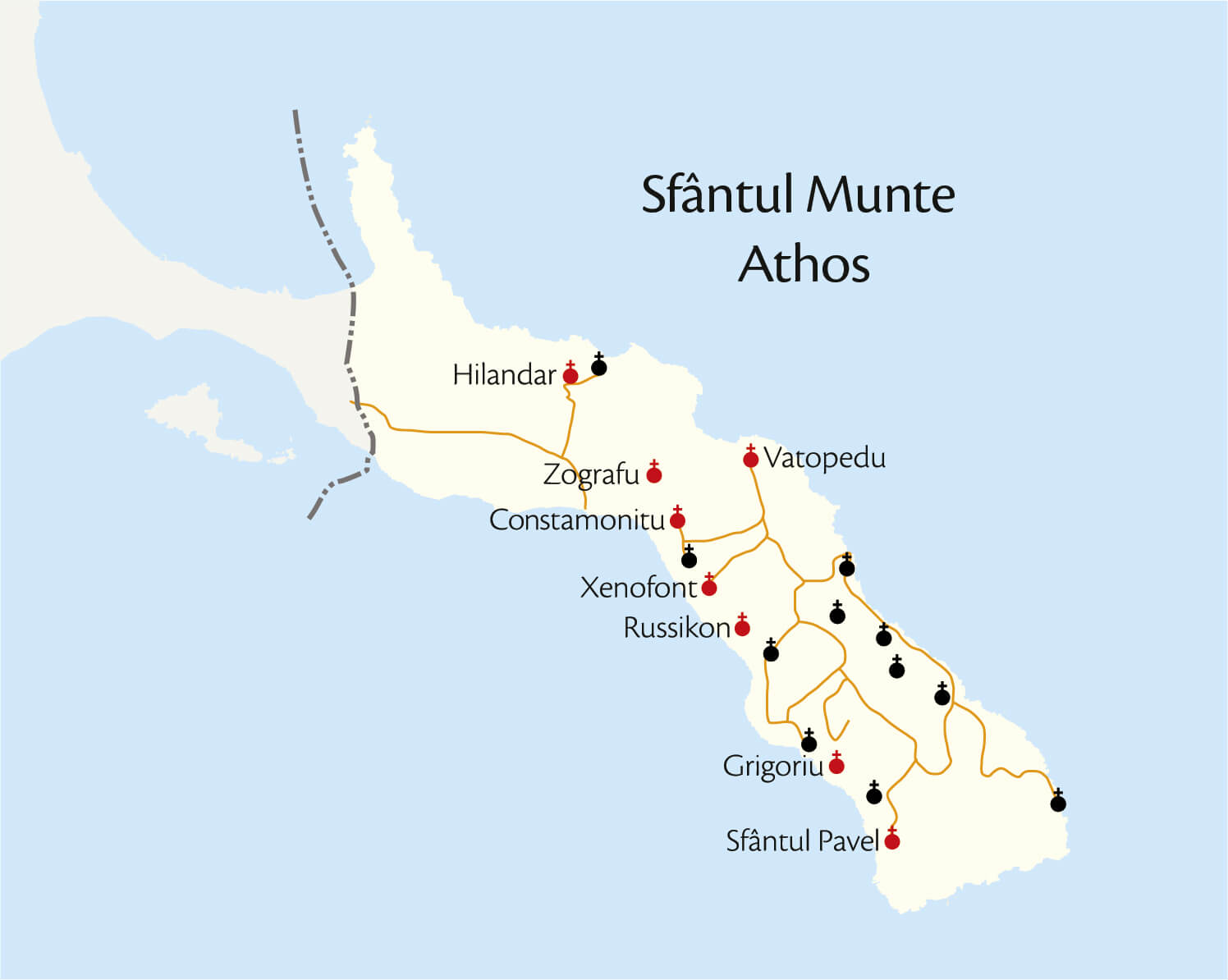According to the Chronicles of the Land of Moldavia written by Grigore Ureche, Prince Stephen the Great was venerated as a saint as soon as he reposed into the Lord on the 2nd of July 1504: “After his death, until today, he is remembered as Holy Voivode Stephen” – noted the chronicler. His spirit of sacrifice justified this popular glorification, as he had always been ready “to taste death a hundred thousand times” rather than leave his country, Moldavia, prey to the ungodly ones.

Holy Voivode Stephen the Great
Holy Voivode Stephen the Great
Troparion of Holy Voivode Stephen the Great
“Fearless defender of the faith and of our country, great founder of sanctuaries, oh, Prince Stephen, pray Christ the God to deliver us from troubles and needs!”
Opposing the expansion of Islam in Europe, Saint Stephen the Great made Moldavia a “gate of Christianity,” where many of the ungodly ones often had to bow down their heads. “We, with all our power which was given to Us from above by the Almighty God, are always ready, with all Our strength and all the zeal of Our heart, to fight for Christianity” – thus spoke the ruler of Moldavia on the 29th of November 1474.
“The Turks greatly fear this ruler,” wrote Venetian Matteo Muriano in 1502. “He is a very wise man, worthy of much praise, much beloved by his people because he is merciful and right, always ready and generous.” “In my opinion,” wrote another contemporary of Saint Stephen the Great, the important Polish chronicler Jan Długosz, “he is worthy to be entrusted with the leadership and reign over the whole world and, most of all, with the leading position against the Turks, with the consent of all Christians, considering that the others – the Roman-Catholic kings and rulers – spend their time only in idleness and civil wars.”

Christianity saw in this ruler a hope to combat the chaos that was about to be installed in Europe through the expansion of the Crescent Moon – the insignia of the Ottoman Empire – to the Danube. “Your works against the ungodly Turks, our common enemies, accomplished until now wisely and courageously,” wrote Pope Sixtus IV to Saint Stephen the Great on the 20th of March 1476, “brought so much glory to your name that it is now on the lips of everyone and you are greatly praised by everyone, with one heart […]. For the work you have accomplished and you are still accomplishing with godliness and glory, we should indeed thank you.”
His Beatitude Daniel, Patriarch of the Romanian Orthodox Church
Glorification of St. Stephen the Great at Putna Monastery, the 2nd of July 1992
In the Anonymous Chronicle of the Land of Moldavia, Stephen the Great is remembered as the “bearer of victories.” This name is justified in the same chronicle by the description of the battle of Vaslui (1775): “And then it was gladness among the people […] and among all the Orthodox Christians, because the Lord ruled over the pagan tongues through the hand of His servant, Stephen Voivode.” So the ruler of Moldavia was the chosen vessel through which the will of God was accomplished.
His victories came from God and he received them as a gift, just as a candle receives its light and all rejoice in it and much praise the giver of light. The power of Stephen the Great came through the grace of God that dwelt in his heart. He could say together with the Apostle Paul that “we have this treasure in jars of clay to show that this all-conquering power is from God and not from us” (II Corinthians 4:7). Aware of the nothingness of human nature and of its power and, at the same time, being grateful for the grace of God, Stephen the Great understood that the key for conquering every evil, seen or unseen, personal or common, is a humble heart, which attracts the grace of God and the help of His saints. “Stephen did not become arrogant after this victory,” writes chronicler Jan Długosz. “After his victory in Vaslui, he fasted 40 days with only bread and water and gave orders in all the country that no one should dare to attribute that victory to him, but only to God.”
The Cross as a “sign of victory” was a constant presence in the life and reign of Stephen the Great. Thus, the great anti-Ottoman policy (1473–1486) was preceded by a symbolic gesture: the marriage of the ruler of Moldavia with the Byzantine Princess Maria Asanina Palaiologina took place on the 14th of September 1472, the day of the Elevation of the Holy Cross. Another example is the raising in Vaslui – the place of his great victory in 1475 – of three large stone crosses. Also, two of the religious sites that he founded were dedicated to the Holy Cross: Pătrăuți Monastery and the church from Volovăț. In the votive icon from Pătrăuți, Saint Stephen is represented before the throne of Christ, having Saint Constantine the Great as an intercessor, who was “the model monarch for Stephen and the first one to be victorious under the sign of the Cross.” Because the dedication to the Holy Cross was singular in Moldavia, it is believed the monastery must have possessed a piece of the true Cross of Christ. On the western wall of the narthex is an extensive composition (singular as well): the Cavalcade of Holy Emperor Constantine – which had never been represented before in Romanian Orthodox frescoes. Some of the churches founded by Saint Stephen – such as Voroneț, Dobrovăț and Reuseni – were consecrated on the day of the Elevation of the Holy Cross, the 14th of September.

On the 14th of September 1486, the activity of the princely chancery was resumed after a period full of trials which Moldavia experienced following the loss of its fortresses on the sea (1484) and after the event that took place at Șcheia on the 6th of March 1486. “Stephen Voivode was defeated by Peter Hronoda then and he fell down from his horse and lay among the dead ones from morning till noon,” says the Moldavian-Germanic chronicle. It is believed that those dramatic moments constituted a milestone between two ruling periods of Stephen: the Great Policy (started in 1473) with its great deeds of bravery, and the Great Prayer (1486–1504) characterized essentially – but not exclusively – by the founding of more than 30 churches and monasteries.
Stephen the Great’s Legacy
Stephen was great because he was humble
The more he humbled himself
So that God could see him
United with his people forever
To get to a nation’s heart
The narrowest of gates
If you are not sacrificed in their tears
You cannot reach eternity
Ioan Alexandru
The statue of Stephen the Great in Kishinev’s Great National Assembly Square was installed between the two World Wars, when the historic Romanian region of Bessarabia was part of Greater Romania, just as it had been part of Prince Stephen the Great’s Moldavia.
The help of military saints was constantly invoked by the great prince of Moldavia. To ensure their help, he fought some of the battles exactly on their feast days: the Battle of Râmnic from 1481 was started on Saint Procopius’ feast – the 8th of July; the Battle of Codrii Cosminului started on Saint Demetrius’ day – the 26th of October; the 1473 campaign in Wallachia was on the 8th of November – the feast day of the Archangel Michael. About the first battle mentioned above, chronicler Grigore Ureche confessed: “They say that Holy Martyr Procopius was seen above the army of Stephen, coming to his help and giving courage to his army. This account is worthy to believe because, once the army returned with Stephen, who received great honor as a conqueror at his seat in Suceava, Stephen founded a church dedicated to Holy Martyr Procopius in the village of Badeuți, which exists to this day.”
The victory from Codrii Cosminului is also significant. While King Albert, defeated in the war that had been “prepared with plans and fought in an unworthy manner,” was hiding his loss “by living day and night in banquets and parties, in games and in women’s choirs and asking everyone in his sight to pretend to be joyful,” Prince Stephen celebrated the victory differently. From the place of battle, he went to Tazlău Monastery, whose foundation he had already begun on the 4th of July 1496, and he had it consecrated on the 8th of November, the feast day of the Holy Archangels Michael and Gabriel. From Tazlău, the prince went to Neamț Monastery, whose building was also finished, and had it consecrated on the 14th of November, the feast day of Saint Gregory Palamas, the father of hesychasm and unceasing prayer. The dedicatory inscription in the church is in itself a prayer through which we can still hear the echoes of the grave events through which Moldavia had recently been: “Lord Christ, receive this house, built with Thy help, for the glory and honor of Thy Holy and glorious Ascension from earth into the heavens; and Thee, Lord, cover us with Thy mercy, from this day unto all ages.”
The reign of Stephen the Great occupies an proeminent place in the history of the Romanian people. This perception is not a late creation, a “myth” forged by a circle of scholars or a political regime. (Ștefan S. Gorovei, historian)The consecration of the Neamț Monastery was followed by the ceremony at Hârlău on the 6th of December 1497, held 40 days after the victory at Codrii Cosminului. A memorial service was officiated for those who died during the fight. And then valuable gifts were given to the bravest ones. “And they were sent back home and he taught them to praise and bless God the Most-High for what He had given them, because there is no victory except from God.”
The inscription on “Stephen the Great’s Banner”
Oh, Holy Martyr George, who are patient in torments and bearer of victories, quick defender and warm helper in our needs and troubles, unspeakable joy to the afflicted, receive this prayer from your humble servant Io Stephen Voivode, by the grace of God prince of Moldavia, and preserve him unharmed in this age and in the one to come, for the prayers of those who honor you, so we can glorify you forever in eternity. Amen.
The “Banner of Stephen the Great” was donated by the prince to Zographou Monastery on Mount Athos around 1500. Now it is displayed at Romania’s National Museum of History in Bucharest.
Holy Great Martyr George was another saint beloved by Stephen the Great. This saint was depicted on the flag of war of the Moldavian army with a sword in his hands and a dragon (a symbol of the pagans) under his feet. For all Christianity, Saint George was the protector of the crusaders, being himself depicted as a crusader. In the beautiful prayer written on the margins of this icon, the ruler of Moldavia asks this saint, “bearer of victories, quick defender, and warm helper,” to “preserve him unharmed in this age and in the one to come.” The churches at Hârlău (1492), Baia, and Voroneț (1488) were also dedicated to the saint. In the votive picture from Voroneț, Saint George intercedes with Christ for Stephen the Great, his hand being in a familiar and friendly way around Stephen’s shoulder. Certain gifts (such as the one from 1460 to Bistrița Monastery or the Gospel Book of 1502 to Zographou Monastery) were donated on the feast day of this saint – the 23rd of April. A very beautiful icon of the “Trophy bearer” was given by Stephen the Great to Zographou Monastery. Almost all the epitrachelia ordered by Stephen the Great had the icon of Saint George.

The Mother of God had a special place in Stephen the Great’s heart: to her Dormition he dedicated “his beloved monastery” Putna, the necropolis of his family, as well as the church from Borzești – the place where it is believed that the great ruler was born. Two of the most beautiful embroideries (1485) in Romanian medieval art – representing the scenes of the Annunciation and the Dormition of the Mother of God – were made “on my order, Stephen Voivode” and given to the Punta Monastery. Also, one of the prince’s daughters was given the name of the Mother of God.
The ruler of Moldavia asked the help of other saints, too, building churches in their honor: for the Mother of God (the churches in Putna, Borzești, Tazlău), for Saint Nicholas (Chilia, Iași, Dorohoi, Popăuți), for Saint Elias (Suceava), for Saint John the Baptist (Vaslui, Piatra Neamț, Reuseni), for Saints Peter and Paul (Huși), for Saint Michael the Archangel (Războieni), for Saint John the New (Bistrița, Piatra Neamț), for Saint Paraskeva (Râmnicu Sărat, Cotnari), and for the Archangels Michael and Gabriel (Scânteia).

In 1463, Stephen the Great made a reliquary for the head of Saint Simeon the Stylite from the Wonderful Mountain which is kept to this day at Neamț Monastery. This saint lived in the 6th century near Antioch and reposed in the Lord on the 24th of May 596. On the 1st of May 1488, the Voivode placed in a reliquary the relics of Holy Hierarch Gennadius and brought them to Putna Monastery.
Saint Stephen the Great was closely involved with the fate of the monasteries from Mount Athos, providing material support to them. Among them, the monastery which received most of his gifts was Zographou Monastery.
On the 10th of May 1466, he settled a yearly gift of 100 golden florins, asking in return from the fathers of the monastery to be remembered at the Holy Liturgies together with his wife and their children: “First of all” – he wrote in his charter of donation – “I would like to be remembered at the Holy Proskomedia, according to the rules of our Holy Fathers and of our Holy Church.”
Stephen the Great showed through his words that he was an authentic child of the Church, observing Its canons. He did not search out any other way of salvation or, worse, try to impose on the Church things outside Its tradition, but he chose to obey Its commandments. Being remembered at the Holy Liturgy is a thing of the utmost importance for the soul. Through this, the soul is mystically united with God Himself, becoming one with Him. This union inspires in man the desire to do the will of God and he is protected in everything he does by the divine power.
None of our chronicles leaves unmentioned this quality about Saint Stephen. Thus, the fortress of Chilia was conquered in 1465 “through the will of God”; in the fight from Râmnic “God helped Stephen and he won”; at Vaslui, “God made the pagans pass through the sword’s blade”; and, afterwards, receiving the news that the sultan was gathering a great army against him, Stephen “was waiting fearlessly, putting his trust in God’s help”; at Cătlăbuga “by the mercy of God, Stephen Voivode won”; his defeat at Valea Albă is also considered as having been allowed by God – as a punishment for his sins – even then, Stephen gave glory to God.

In 1471, Stephen the Great granted to the Zographou Monastery an income of 500 aspri for the infirmary, and between 1475–1495 he built the refectory of the monastery and a tower for the ships. In 1475, Stephen, “burning with godly desire and zeal and ready to hear the words of Christ, Whose love he longed for,” devotedly had the Words of Abba Dorotheus copied for the monastery. On the 23rd of April 1502, “Io Stephen Voivode […] ever ready to hear the words of Christ, Whose love he longed for,” had a Gospel Book copied and covered in silver by the hand of monk Philip. Other two manuscripts – The Apostle (1463) and the Acts of the Apostles (1463) – were also given to Zographou monastery. In 1488 two silver cherubims were offered, and in 1500 two banners with the icon of Saint George.
At the Gregoriou Monastery, Stephen the Great built a bell tower in 1502, restored the church, and, around 1500, completely renewed the monastery. With the support of its benefactor, the monastery bought the hermitage of Saint Tryphon. Stephen the Great’s consort, Lady Maria Asanina Palaiologina, gave to Gregoriou Monastery an icon on whose cover had been written the following words: “The prayer of Lady Maria Asanina Palaiologina, Lady of Moldo-Wallachia.” At the beginning of the 18th century, the Russian traveler Barskij noted that Stephen the Great from Moldavia was the second founder of the Gregoriou Monastery, after Saint Gregory of Sinai, its first founder.

Documentary sources from the 15th century certify that even in his lifetime people attached the attributes of a saint to Stephen the Great’s name. Thus, the Anonymous Chronicle of the Land of Moldavia, describing the events between 1475 and 1481, mentions that the ruler of Moldavia returned to Suceava “as a Trophy bearer” – an attribute of Saints George and Demetrius, but also of Constantine the Great. The latter was, very likely, the foremost life model for Stephen the Great.
Maciej Stryjkowski, a Pole passing through Moldavia in 1575, noted that Stephen, “because of his undefeated bravery, is considered a saint [by the Moldavians].” The Polish chronicler Bielski also wrote in his Kronica Polska: “For those great victories, even if he had a small country, every history book could place [Stephen] next to the greatest and most important army leaders; this is why even the Moldavians call him Kara Bochdan, meaning ‘Cherished Bogdan,’ and for his bravery beyond all measure they consider him to be a saint.”
On the 16th of May 1920, in front of Stephen the Great’s tomb, King Ferdinand the Unifier of Romania delivered a touching speech:
“Stephen of Moldavia, you have lived for centuries in the souls of Romanians and will live forever...
Inspire our hearts with the spirit of holy union, so we can carry forward the heavy burden of our unified State.”
The decision concerning the glorification of Saint Stephen the Great was taken by the Holy Synod of the Romanian Orthodox Church on the 20th of June 1992: “Concerning the life full of sacrifice for the faith and the nation of the right-believing Voivode, We hereby decide that from now on until the end of time, Prince Stephen the Great of Moldavia be numbered with the venerable and holy fathers of the Church, being honored with services and songs of praise on the 2nd of July, being included in the Synaxarium, in the service books and in the calendar of our Church with the name of the ‘Right-believing Voivode Stephen the Great and the Holy’” (Synodal Canonization Decree). ). Starting from July 2004, the time-consecrated name of “Holy Voivode Stephen the Great”is to be used.
The generations at the beginning of the 3rd Millenium carry Holy Voivode Stephen the Great in their souls, remembering his worthiness, and have rewarded him the title of the “Greatest of All Romanians”, while the Church has painted him on icons and daily officiates the thanksgiving liturgy in the soul of Romanians and at his tomb from Putna.











